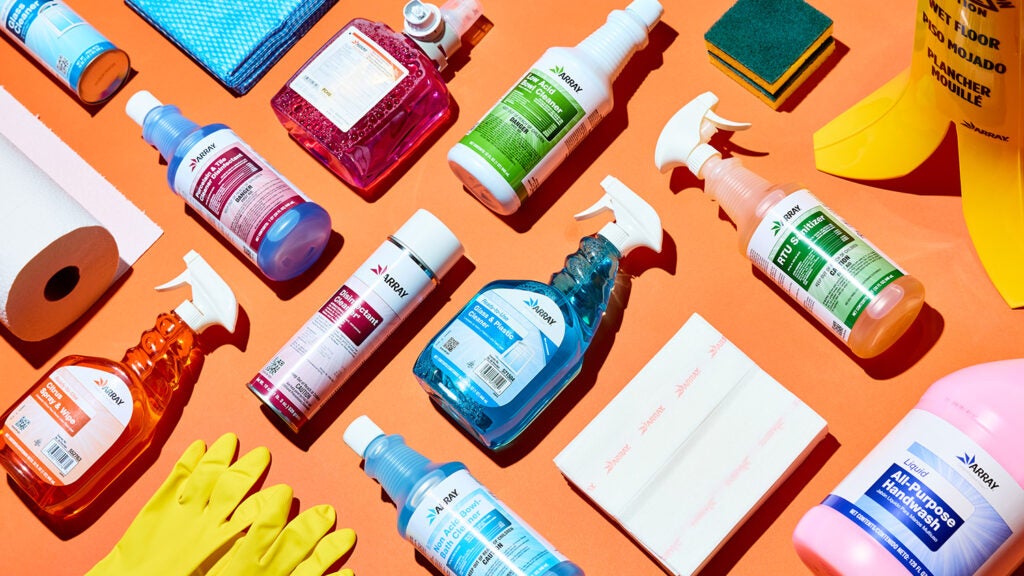Cleaning and sanitizing food contact surfaces is one of the most important steps to prevent foodborne illness. Food residues on food contact surfaces and equipment can provide an ideal environment for the growth of disease-causing bacteria. If food contact surfaces are not cleaned properly, bacteria may multiply to dangerous levels. Using ready-to-use cleaners, sanitizers, and disinfectants can help reduce and prevent the start of food borne illnesses.
Food contact surfaces are defined as any surface that touches food such as knives, stockpots, and cutting boards. Effective cleaning and sanitation of food contact surfaces serves two primary purposes. The first being to reduce the chances of contaminating safe food during preparation, storage, and service by removing bacteria and other microorganisms. Secondly, it minimizes the chances of transmitting disease organisms to the consumer.
Four Simple Steps to Cleaning and Sanitizing
Maintaining a clean and sanitized environment is crucial for health and safety, whether in a home, restaurant, or any workspace. These four simple steps, when followed diligently, will significantly reduce the presence of harmful bacteria and viruses, ensuring a more hygienic space.
- Clean the surface
- Rinse the surface
- Sanitize the surface
- Allow the surface to air-dry
When and How to Clean and Sanitize Food Contact Surfaces
- After usage
- Before foodhandlers start working with a different type of food
- Any time food handlers are interrupted during a task and the items being used may have been contaminated
- After four hours if items are in constant use
Dishwashing Machines
Tableware, glassware and small kitchen tools can be used in a dishwashing machine. A dishwashing machine can sanitize by using either hot water or a chemical sanitizing solution.
High-temperature dish washing machines use hot water clean and sanitize. The temperature of the final sanitizing rinse in a dishwashing machine must be at least 180℉ to properly ensure the food contact surfaces have been disinfected. For stationary rack, single temperature machines, water temperatures must be at least 165℉, and the dishwasher must have a built-in thermometer to check water at the manifold where the water sprays into the tank.
Chemical sanitizing machines can clean and sanitize items at much lower water temperatures and are dependent on the machine’s design and manufacturer.
Three-Compartment Dishwashing Sinks
Larger kitchen items are often cleaned in a three compartment sink. Rinse, scrape, or soak all items before washing them in a three-compartment sink.
Take these steps to sanitize food contact surfaces in a three-compartment sink:
- Wash items in the first sink in a detergent solution that is at least 110°F
- Rinse items in the second sink by immersing or rinse them in clean water or by spraying them off with the kitchen sprayer
- Immerse items in the third sink in hot water at or above 171°F, or in a properly prepared chemical sanitizing solution
- Air-dry all cleaned and sanitized items before storage
Stationary Equipment
Equipment manufacturers typically provide instructions for properly cleaning and sanitizing stationary equipment; but in general, follow these steps:
- Unplug the equipment
- Take off any removable parts and wash, rinse, and sanitize them by hand
- Scrape or remove food from equipment surfaces
- Wash equipment surfaces with a cleaning solution and proper cleaning tool (e.g. nylon pad or cloth towel
- Rinse equipment surfaces with clean water
- Sanitize equipment surfaces
- Allow all surfaces to air dry and then put the unit back together
By consistently adhering to these cleaning and sanitizing procedures, you can significantly mitigate the risk of foodborne illnesses and maintain a safe and hygienic environment. Remember, thorough cleaning followed by proper sanitization is the cornerstone of food safety. To ensure you have the right tools for the job, browse our comprehensive selection of cleaners, sanitizers, and degreasers.











